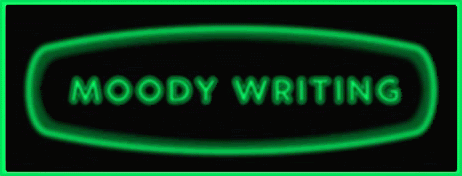Looking for trouble? You better be, because story is all about conflict and tension. Trouble needs to be in the rear view mirror or on the horizon or next to you in the passenger seat, or all three. If it's happening right now then you should have the reader gripped. Of course, you don't always want to be in the middle of it. But even when you're in between moments of high drama there should still be a sense of it around.
If trouble is approaching then it needs to be foreshadowed. A man sunbathing on the beach feeling relaxed and happy is not very interesting. Even if it is intended as the lull before the storm and a few paragraphs later an aeroplane falls out of the sky into the ocean in front of him, that section of him catching rays needs to have something about it that suggests the approaching catastrophe.
You can do that in many ways (and I will go into that little later) but if you don't, if you decide you want the contrast of a relaxed easygoing moment before things go haywire, the problem is people will skim it and there's nothing you can do to stop that if you don't add some kind of tension.
If the trouble has already happened, then you need to show the after-effects. Delaying that by having characters acts in a mundane and everyday fashion will again just get skipped over by impatient readers. That doesn’t mean you have to have them falling down weeping about how terrible things have been, but it does mean keeping the storyline connected to whatever it is that’s happened.
Trouble can mean a variety of things. It doesn't have to be earth-shattering or life threatening. What it should mean is that the character cannot continue as they wish and ignore whatever the problem is even though in real life we do that all the time. The size of the trouble isn't the important thing, even big problems can be ignored, the important thing is that trouble gets in the way and can't be avoided.
So, trouble could mean losing your job, killing a man, finding out your daughter is dating a boy, or losing your keys. Any story will contain a variety of issues like this and mostly what they will do, apart from keeping the story moving, is reveal how your character deals with his life.
Over at Writing at High Altitude, Margo has been discussing the concept of micro-tension as used by Donald Maass in his book Fire in Fiction. There's been quite an interesting debate that you can find here (btw, when I first started blogging in February the book I saw mentioned most often on writing blogs was Save the Cat, now it's very much the Maass books. Interesting to see how quickly these things change). Having read the chapter in the Maass book about this, I would say it's a concept that is quite straightforward to grasp in general terms, but very hard to apply specific examples that may not lend themselves to easily creating tension.
My own take on micro-tension is this: every piece of dialogue or action or narrative needs to suggest more than basic facts and information. In order to do this you can simply adjust the tone of delivery to become slightly more antagonistic and that will create tension. For example:
Jack stood at the bus stop. The buses arrived every 15 min and the journey to work took half an hour.
In this example let's say I am giving you facts about Jack's journey that you will need to know for later events to make sense. The information is very straightforward and dry exposition. However, you can add tension by doing something like this:
Jack stood at the bus stop. Supposedly the buses came every 15 min but that was a joke. And they were always crammed full. Half an hour of sweaty armpits to look forward to.
By creating a sense of dissatisfaction, even if it's within the character's own mind, we create conflict between the idea of the bus coming and his issues with the service. That's where the tension comes from, opposing ideas within a single thought. By taking any dialogue or action and looking for ways to change it from a direct exchange of information to questioning whether it's actually as straightforward as it seems, even if it’s only subtle, will make the reader push on to find out how it turns out.
"Where are you off to?"
"I’m going to the store."
Compared to:
“Where are you off to?"
"Gonna try to get to the store before it closes."
Suddenly makes it less of a done deal.
Obviously, it depends on the context of your story but changing the approach from a need to tell the reader what's happening to first considering how it affects the characters and putting the characters voice and attitude into the delivery can make all the difference.
Even if the questioning tone doesn't prove to be justified, the increased tension will keep the reader moving through the text.
"Having got that money you owe me?"
"Yeah." Mike took out his wallet and handed over $20. "There you go."
You can have the same result, but with tension, just by doing something like this:
"Having got that money you owe me?"
"Yeah." Mike put his hands in his trouser pocket, and then in his jacket pocket. "Hold on." He patted his backside and then checked his inside jacket pocket. He tried his trouser pockets again and this time brought his hand out with a crumpled twenty in it. "There you go."
A big part of this is knowing your characters and knowing what is an issue for them. Often it can just be an issue they have with themselves, to do with self-doubt or reluctance. The enemy of tension is straightforward, easy accomplishment. Finding ways to make things harder, even if it initially seems such a normal thing that nobody will really care, makes a big difference to the reader who is like a tourist in a new city where streets and houses all look different from the ones back home.
This is all how I perceive micro-tension can be used as a tool. I don't really know if this is what Maass meant exactly and would be very interested to know what others think both about the Maass approach and what I have set out above.






































































































19 comments:
I know what you mean about skipping by parts that appear mundane. Problem is, you never know what you miss.
Again a great and helpful post! No need to read books, I just come to your blog :)
Great post! So true, every page needs to be dripping with drama.
Sarah Allen
(my creative writing blog)
You've nailed exactly the reason why I set aside my first, half-finished, novel a few years ago. It didn't have enough tension and I realised I had not yet matured enough as a writer to do the job properly. One day I'll get back to it, but only after reading and learning to apply advice like this. Thank you!
Loved the post. Its important to show both internal and external conflict. Tension is a vital ingredient to get reader involvement. Thanks for the great examples,they are easy to understand.
Happy Easter. Have a great weekend.
Not familiar with the Maas approach (will look into it) but everything you've said makes perfect sense, as usual, and the examples are excellent.
Thanks :-)
Will check out Maas, I'm still trying to get around t.o reading Save the Cat :)
Wagging Tales - Blog for Writers
Sound advice! That's where the eerie music comes in when you're watching a movie. We always get a sense of what's to come by the music. And we just dont have that luxury with the written word.
I liked your examples of how to up the micro-tension. Most of the examples in the excerpt Margo looked at were between characters, so it was good to see these small internal/environmental conflicts.
- Sophia.
Great post! Love it :O)
I think your examples showed micro-tension perfectly. The example from Girl With a Pearl Earring shows micro-tension between characters, because it's a first chapter and it's all important to introduce the characters. But as a book proceeds and we have instances of description or exposition between moments of character interaction, one must find ways to pull in micro-tension other ways, as your example with waiting at the bus-stop shows. Thank you for the mention and the discussion... now off to implement.
Awesome post. Tension on every page is the key for sure. Love this post!
Great post. Even though I write fantasy, I read lots of suspense and mystery because they have to be experts at foreshadowing.
When I was reading from one Sol Stein's books I loved how he and another writer, in a writing exercise, were each given different "scripts" as players and then they had to act them out (not knowing they were operating on different scripts). Talk about conflict!
When I was about five I told my mom, "If there's no conflict, there's no story."
It scared the crap out of her.
This is an excellent description of micro tension. It adds life to your story creating the appeal necessary to keep the individual reading.
Great examples. Who was it that said, "Nobody wants to read about the village of the happy people"?
Tension does add the suspicion of suspense!
Great post~
Agreed! Tension and foreshadowing are important. And I, personally, love 'em :D
GMC/Tension and foreshadowing. All musts! Great post. :)